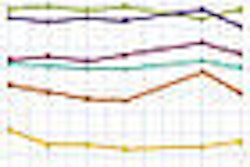As the practice of healthcare moves from a fee-for-service to a value-based reimbursement model, radiologists must highlight their most important contribution to patient care -- clinical information -- rather than focusing only on producing and interpreting images, says a commentary in the November Journal of the American College of Radiology.
"If we can communicate to our physician colleagues how a radiology consultation up front can translate into time savings for them and others downstream, we can make a powerful argument for the value of the data we provide," lead author Dr. Christoph Lee, of the University of Washington School of Medicine, told AuntMinnie.com. "It's not so much about the written report we produce, but the actionable information we get to physicians in acute care settings."
Historically, radiology has not measured the value it adds to patient care, and it certainly has not communicated this value to referring doctors or patients themselves, Lee and colleagues wrote. This needs to be corrected for the specialty to be prepared for changes in payment models. A good way to measure value is to measure physician time -- specifically, how radiology's clinical data make patient care more efficient and effective (JACR, November 2012, Vol. 9:10, pp. 713-717).
"Using physician time in the most efficient way will be a key element for decreasing healthcare costs at the aggregate level ... [and] expressing radiology's contribution in terms of downstream physician time saved is a metric that can be easily understood," the authors wrote. "In a conceptual [payment] framework centered on value, the specialty of radiology must focus more on its most important product, actionable information, rather than on imaging technologies themselves."
Time is money
It's not that the concept of time as a measure of value is new. Radiology has been measuring time spent providing services for years through the relative value unit (RVU) system, which assesses value as the product of time required for a service and the intensity of work per unit of time. Unfortunately, the current system has led to excess utilization that the federal government has addressed with blunt approaches such as the Deficit Reduction Act of 2005, which lowered reimbursement rates for advanced imaging, Lee's team wrote.
But measuring the total cost of a patient-care cycle requires different data and an allocation metric, according to the group, which cited research that suggests a "time-driven activity-based costing" system to assign costs to each process in a patient's episode of care.
When costs and outcomes are measured around patients, resources are reallocated so that clinicians who are more efficient get more attention, they wrote.
"In this system, costs are no longer analyzed at the specialty or department level; instead, costs consist of treating individual patients with specific medical conditions in their full cycle of care," the authors wrote.
A stitch in time ...
Radiologists provide clinical data important to patient care, they noted -- and unlike equipment, information does not depreciate. PACS networks archive imaging data so that radiologists can be consulted at a later point by the clinical team to identify modified and perhaps new actionable information.
"In essence, the initial acquisition of images becomes a fixed cost, but the continuous exchange or extraction of diagnostic information between radiologists and multiple downstream consultants is a matter of increasing returns," Lee and colleagues wrote.
Radiology needs to move from an "interpretation mindset" to one of creating and organizing information that improves the accuracy of medical decisions and lowers costs, according to Lee.
"Mapping out the time points when radiologists interact in the whole patient-care cycle, and continuing to provide clinical information, will highlight radiology's consultation strengths and make clear how valuable the specialty is," he told AuntMinnie.com.



















